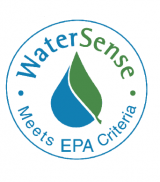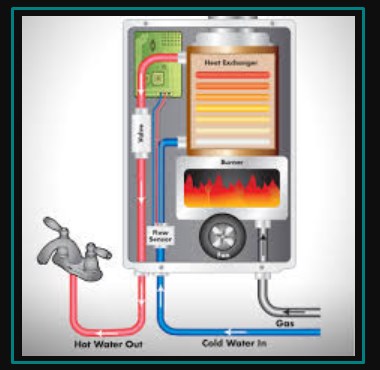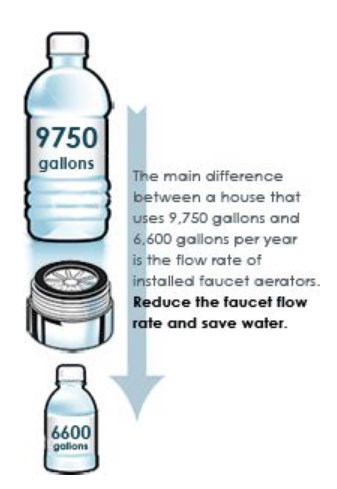
As you already know, conserving water helps to preserve the environment. It also means paying less in water bills every month. Are looking for tips on how you can preserve this precious commodity in the bathroom.
Well, you’re in for a ride because I’ve collected 50 actionable tips that you can start implementing today…
Let’s dive right in.
Water Saving Tips in the Bathroom
1. Use water saving shower heads– Install a shower-head that uses no more than 2.0 gallons per minute (GPM). The shower head you use should have the WaterSense Label.
2. Take short showers – Avoid taking long showers as they use a lot of water. Timing yourself helps to monitor the time taken in the shower. Taking a cold shower helps to avoid indulging oneself. (maximum of five minutes)
3. Use a Steam Shower: Instead of using water, you can use steam to clean your body. A steam shower works by boiling water to steam. The amount of water used is tiny compared to a normal shower.
4. Put a bucket in the shower- When waiting for the shower water to get to the right temperature don’t let the cold water to go to waste. Put the bucket under the showerhead and collect the cold water. In addition, when you are using a wall-mounted showerhead, you can place the bucket in such an angle that it will continue collecting water as you shower. You might be asking yourself “what will I use the water for?” Don’t flush the toilet every time you pee but use the bucket water.

5. Install high-efficiency toilet: Regular toilets use 2.5- 5 gallons per flush while water saving toilets can only use up to 1.6 gallons per flush. You will save lots of water over time by using a more efficient toilet. Check the table below.
6. Take a shower not a bath– According to North Carolina State University, a bath usually consumes 30 gallons of water while a normal shower will consume 10-25 gallons of water. You should think of a bath as an occasional treat but not as the norm.
7.WaterSense faucets: When buying showers heads ensure they have a WaterSense label.
8. Use a tank-less water heater: Tank-less water heater not only saves on energy but also use less water because water is heated at the point of use.

9. Use soap instead of shower gels: On average using shower gel consumes more water than using a bar of soap. This is because it takes more water to rinse a shower gel compared to soap.
10. Turn off the water while shaving: It may surprise you how many people simply let the water run while they shave. You should develop the habit of turning off the tap while shaving.
11. Use faucet aerators: Installing a faucet aerator reduces the gallons per minute of water flow because faucet aerator mixes air with water producing a steady stream.

12. Turn off the water while brushing teeth: Train your kids and everyone in the house to turn off the tap while brushing their teeth.
13. Fix leaks: Check all faucets, pipes, and toilets periodically for leaks
14. Avoid using the toilet as a wastebasket: Using the toilet as a wastebasket leads to consuming of lots of water when flushing.
15. Turn off the shower when lathering– Don’t let water to keep on running while you are lathering yourself, but turn off the water.
16. Avoid Drips in faucets: One drip every second adds up to five gallons per day.

17. Hang Bath Towels to Dry– Save water by hanging your towel to dry instead of washing it every day.
18. Teach kids to save water: Sensitize kids on the need to save water from an early age.

19. Plug the bathtub before turning on water: When running a bath, plug the bathtub before turning on the water
20. Rinse your razor in the sink: Simple technique of saving water and making shaving.
21. Turn off Faucets Tightly: You should make it a habit of turning faucets tightly to avoid drips. In addition, Teach children to turn off faucets tightly after each use
22. Limit the number of flushing: Avoid unnecessary flushing
23. Use Half-flush toilets: Install toilets with half flush options. Use the half-flush option to avoid wasting water.
24. Collect rainwater: You should have you plumber build a system to collect rainwater and use rainwater for flushing.
25. Insulate your hot water pipes: Insulating hot water pipes ensures that you don’t wait for long time for hot water to start flowing, so you don’t waste lots of water. Insulating pipe not only helps you to save water but also helps in conserving energy.
26. Use thermostat for water heating system: A thermostat helps to regulate water temperature; thus, avoiding the temperature from going too high which results in more water being used to bring the temperature down.
27. Plug your sink when washing hands and face: There is a reason why sinks have a plug installed. You should plug the sink when washing your hands, face or shaving.
28. Check for leaks: Regularly check for leaks in pipes, faucets, sinks, and toilets.
29. Use a bucket to clean: Always have a bucket when cleaning the bathroom instead of using a hosepipe.
30. Use Water budgets: Set a goal on the amount of water your household will use and strive to leave within the budget.
31. Monitor your water bill for spikes: You should be on the lookout for sudden increases in your water bills which might indicate leaks.
32. Use your meter to check for Leaks: Check for leaks by closing all the faucets and then checking the meter if it’s still running.
33. Check for leaks in the toilet bowl: Put food color in the toilet flush and see if it will leak to the bowl.
34. Replace broken flushing flappers: If the toilet flapper does not close properly after flushing replace it.
35. Use Flow Regulator on you showerheads: Use Showerheads with flow regulators. Flow regulators limit the flow to 2.0 Gallons per Minute.
36. Ensure you have closed all the taps before going to sleep or leaving the house: Always double check all the taps are closed regularly to avoid leaving the water running over a long period of time.
37. Take Timed showers: A shower should not last for more than 5 minutes. You should make a habit of taking quick showers.
38. Use a shower not a bucket to clean yourself: Many people wrongly assume a showerhead consumes more water than the good old bucket. But using a bucket consumes more water by up to 50%.
39. Limit the Number of bathroom visits: You should not go to the bathroom unless it’s necessary.
40. Washing machine: You should use the washing machine fully loaded instead of half full.
41. Confirm all the faucets are closed: If you leave in an area where there is occupational water outage or rationing. You should confirm that all the faucets are closed before going to sleep or work. To avoid water going to the waist when water returns.
42. Take shorter showers- According to “The average American uses 25,300 gallons of water per year. Taking short showers will help reduce the waste of this precious resource
43. Water Games: Teach your kids to avoid playing water games as the lead to lots of wasted water.
44. Home water Audit calculator: Use water audit calculator to see where you can save on water usage at home.
45. Use Qualified Plumbers: To avoid problems with your plumbing only engage qualified plumbers who have the necessary skills and experience.
46. Water softeners: If you have installed water softeners make use of the water it uses for backwashing instead of letting it go to waste.
47. Use Public swimming pools: Instead of building your own private swimming pools, you should utilize public swimming pools.
48. Use a broom: When cleaning the bathroom or the outdoors, you should use a broom instead of using hose pipe which consumes more water.
49. Master water shut-off- You should make the master shut-off accessible so that in case you have pipe bust you can quickly shut off all water supply in the house.
50. Report major leaks: If you notice a major leak either on the road you should report to your local water company.
Related Posts
ABOUT LEON SMITH
 Leon is a 27-year-old blogger from Mauritius who is currently studying for a Masters degree in chemical and processing Engineering at the University of Eldoret in Kenya. Read more about him.
Leon is a 27-year-old blogger from Mauritius who is currently studying for a Masters degree in chemical and processing Engineering at the University of Eldoret in Kenya. Read more about him.